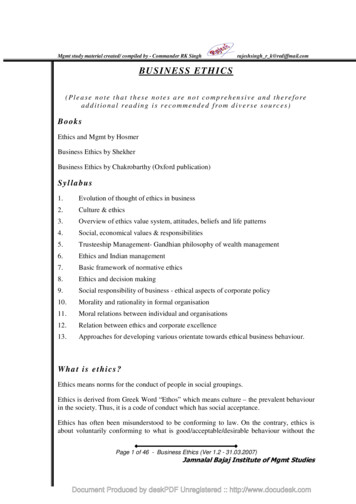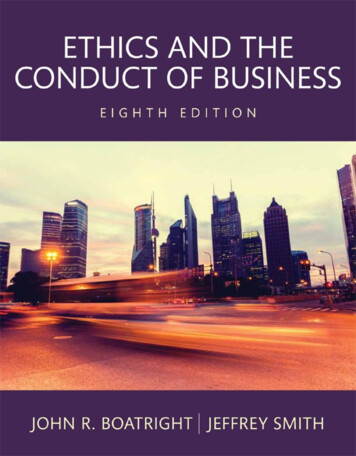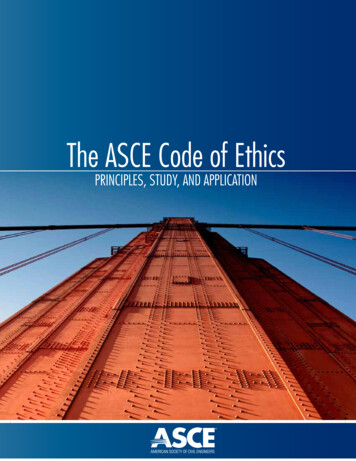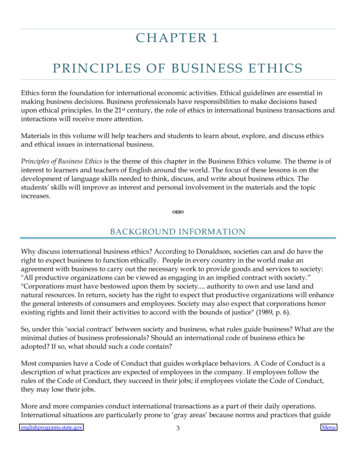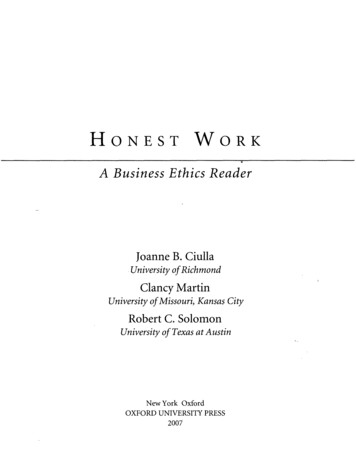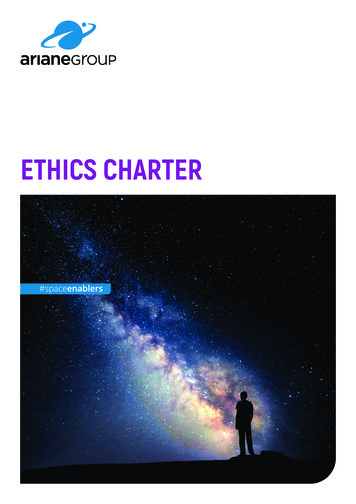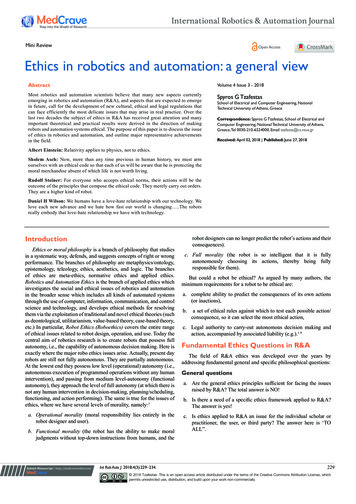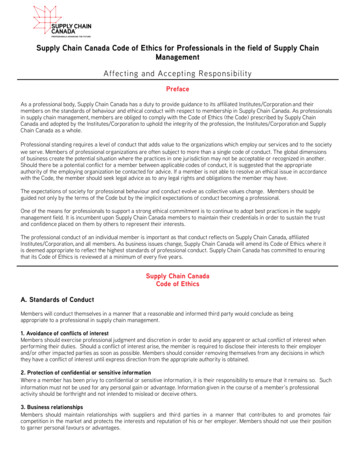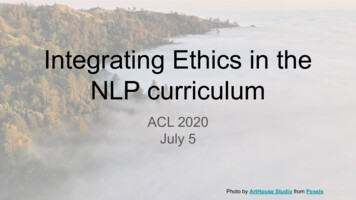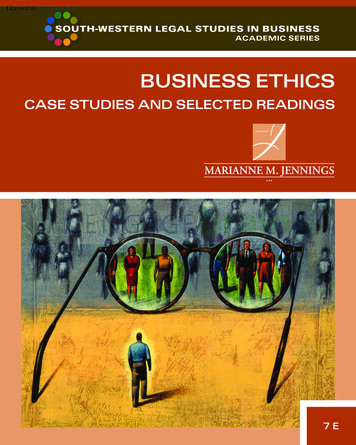
Transcription
Licensed to: iChapters User
Licensed to: iChapters UserBusiness Ethics: Case Studies andSelected Readings, Seventh EditionMarianne M. JenningsVice President of Editorial, Business:Jack W. CalhounEditor-in-Chief: Rob DeweyAcquisitions Editor: Vicky True-BakerSenior Developmental Editor:Laura Bofinger Ansara 2012, 2009 South-Western, Cengage LearningALL RIGHTS RESERVED. No part of this work covered by the copyrightherein may be reproduced, transmitted, stored, or used in any form orby any means graphic, electronic, or mechanical, including but notlimited to photocopying, recording, scanning, digitizing, taping, webdistribution, information networks, or information storage and retrievalsystems, except as permitted under Section 107 or 108 of the 1976United States Copyright Act, without the prior written permission ofthe publisher.For product information and technology assistance, contact us atCengage Learning Customer & Sales Support, 1-800-354-9706Editorial Assistant: Patrick Ian ClarkMarketing Manager: Laura-Aurora StopaFor permission to use material from this text or product,submit all requests online at www.cengage.com/permissionsSenior Content Project Manager:Colleen A. FarmerFurther permissions questions can be emailed topermissionrequest@cengage.comMedia Editor: Kristen MeereSenior Frontlist Buyer, Manufacturing:Kevin KluckSenior Marketing CommunicationsManager: Sarah GreberProduction Service: MPS Limited,a Macmillan CompanySenior Art Director: Michelle KunklerInternal Designer:Juli Cook/Plan-It-Publishing, Inc.Cover Designer: Tin Box StudiosCover Image: Curtis Parker/StockIllustration Source/Getty Images, Inc.Library of Congress Control Number: 2010938756ISBN-13: 978-0-538-47353-8ISBN-10: 0-538-47353-3South-Western Cengage Learning5191 Natorp BoulevardMason, OH 45040USACengage Learning products are represented in Canada by NelsonEducation, Ltd.For your course and learning solutions, visit www.cengage.comPurchase any of our products at your local college store or at ourpreferred online store www.cengagebrain.comPrinted in the United States of America1 2 3 4 5 6 7 14 13 12 11 10Copyright 2011 Cengage Learning. All Rights Reserved. May not be copied, scanned, or duplicated, in whole or in part. Due to electronic rights, some third party content may be suppressed from the eBook and/or eChapter(s).Editorial review has deemed that any suppressed content does not materially affect the overall learning experience. Cengage Learning reserves the right to remove additional content at any time if subsequent rights restrictions require it.
Licensed to: iChapters UserEthical Theory, PhilosophicalFoundations, Our Reasoning Flaws,and Types of Ethical DilemmasU N I T“In the 21st centurywill occur somethingworse than the greatwars, namely, the totaleclipse of all values.The pain the humanbeast will feel when herealizes he can believein . . . nothing . . . willbe worse than any hehas felt before.”O N EBefore we begin the study of business ethics, we should do some introspection:what does ethics mean to me personally? The purpose of this unit is to provideyou with an introspective look at you and your views on ethics before we bringthe business component to you and ethics.This unit explains three things: what ethics are, why we should care about ethics, andhow to resolve ethical dilemmas. The materials in this unit serve as the foundation forthe study of issues in business ethics. We begin with a personal look at ethics, discusswhy it matters, and then decide how to resolve ethical dilemmas.—Nietzsche“I was very upset thatthere’s that manydishonest people.”—Andrea Reuland, theowner of Trigs ShellStation in Minocqua,Wisconsin, who lost 3.00 per gallon on586 gallons of gas soldduring a 45-minuteperiod when localresidents phoned othersto come and get gasbecause an employeehad made a mistake andentered the price at32.9 cents vs. 3.299per gallon. 87 percent ofpeople who respondedto a survey about theincident said they wouldhave done the samething as the Minocquaresidents.1Copyright 2011 Cengage Learning. All Rights Reserved. May not be copied, scanned, or duplicated, in whole or in part. Due to electronic rights, some third party content may be suppressed from the eBook and/or eChapter(s).Editorial review has deemed that any suppressed content does not materially affect the overall learning experience. Cengage Learning reserves the right to remove additional content at any time if subsequent rights restrictions require it.
Licensed to: iChapters UserCopyright 2011 Cengage Learning. All Rights Reserved. May not be copied, scanned, or duplicated, in whole or in part. Due to electronic rights, some third party content may be suppressed from the eBook and/or eChapter(s).Editorial review has deemed that any suppressed content does not materially affect the overall learning experience. Cengage Learning reserves the right to remove additional content at any time if subsequent rights restrictions require it.
Licensed to: iChapters UserDefining EthicsS EC T I O N1AReading 1.1You, Your Values, and a CredoWe have a tendency to look at folks who get into ethical and legal trouble and say, “I knowI would never behave like that.” You probably would not, but you are only seeing them attheir last step. You did not see the tiny steps that led to their eventual downfall. Study howand why they made the decisions they made. The idea is to try to avoid feeling superior tothose who have made mistakes; real learning comes with understanding the flaws in theiranalyses and reasoning processes as well as the types of pressures that caused them to dowhat they did. Your goal is to develop a process for analysis and reasoning, one that findsyou looking at ethical issues more deeply, instead of through the prism of emotions, desires,and pressures. You are not just studying ethics, you are studying business history. But, youare also studying you. Try to relate your vulnerabilities to theirs. Remember as you readthese cases that you are reading about bright, capable, and educated individuals who mademistakes. The mistakes often seem clear when you study them in hindsight. But their ethicalanalyses at the time they were making these decisions was flawed, whether through poorperspective, pressure, or sometimes, the stuff of Greek tragedies: hubris.One of the goals of this text is to help you avoid the traps and pitfalls that consumesome people in business. As you study the cases in this unit and the others that followtry not to be too hard on the human subjects. Learn from them and try to discover theflaws in their ethical analyses.One step that can give us greater clarity when we face ethical dilemmas is a credo. Acredo is different from a code of ethics and does not consist of the virtues that companies usually list in a code of ethics, such as: we are always honest; we follow the laws.The credo demands more because it sets the parameters for those virtues. A credo is virtue in action. A credo defines you and your ethical boundaries.You get your personal credo with introspection on two areas of questions:1. Who are you? Many people define themselves by the trappings of success, such as how muchmoney they have or make, the type of cars they drive, their clothes, and all things tangible and material. A credo grounds you and means that you need to find a way to describe yourself in terms orqualities that are part of you no matter what happens to you financially, professionally, or in yourcareer. For example, one good answer to “Who are you?” might be that you have a talent and ability for art or writing. Another may be that you are kind, showing those Solomon-like virtues inReading 1.1 to others around you. List those qualities you could have and keep regardless of allthe outer trappings.2. The second part of your credo consists of answering this question: What are the things that youwould never do to get a job? To keep a job? To earn a bonus? The answer to this question resultsin a list, one that you should be keeping as you read the cases and study theindividual businesspeople who made mistakes. Perhaps the title of your list could be “Things IWould Never Do to Be Successful,” “Things I Would Never Do to Be Promoted,” or even “Things3Copyright 2011 Cengage Learning. All Rights Reserved. May not be copied, scanned, or duplicated, in whole or in part. Due to electronic rights, some third party content may be suppressed from the eBook and/or eChapter(s).Editorial review has deemed that any suppressed content does not materially affect the overall learning experience. Cengage Learning reserves the right to remove additional content at any time if subsequent rights restrictions require it.
Licensed to: iChapters User4 Unit 1: Ethical Theory, Philosophical Foundations, Our Reasoning Flaws, and Types of Ethical DilemmasI Would Never Do to Make Money.” One scientist reflected on the most important line that hewould never cross, and after you have studied a few of the product liability cases you will come tounderstand why this boundary was important to him, “I would never change the results of a studyto get funding or promise anyone favorable results in exchange for funding.” A worker at a refinerywrote this as his credo, “I would never compromise safety to stay on schedule or get my bonus.”An auditor in a state auditor general’s office wrote, “I would never sign a document that I knowcontains false information.” The credo is a detailed list, gleaned from reading about the experiencesof others, that puts the meat on Polonius’s immortal advice to his son, Laertes, in Shakespeare’sHamlet, “To thine own self be true” (Hamlet, Act I, Scene III). We quote Polonius without reallyasking, “What does that mean?” The credo takes us from eloquent advice to daily action. The credois a personal application of the lessons in the cases. You will spot the lack of definitive lines in thesecase studies and begin to understand how their decision processes were so shortsighted. The goal isto help you think more carefully, more deeply, and more fully about ethical issues.As you think about your credo, especially who you are, keep the following thought fromJimmy Dunne III in mind. Mr. Dunne was the only partner who survived the near destruction of his financial firm, Sandler O’Neill, when the World Trade Center collapsed on September 11, 2001. Only 17 of Sandler O’Neill’s 83 employees survived the tower’s collapse.Mr. Dunne has been tireless in raising money for the families of the employees who losttheir lives that day. When asked by Forbes magazine why he works so hard, Mr. Dunne responded, “Fifteen years from now, my son will meet the son or daughter of one of our people who died that day, and I will be judged on what that kid tells my son about what SandlerO’Neill did for his family.” His personal credo focuses on both the long-term reputation ofhis firm and the impact his choices can have on his children’s reputations.Discussion QuestionExplain the role “How do I want to be remembered?” plays in your credo?Reading 1.2 The Parable of the SadhuPressure, Small Windows of Opportunity, and Temptation1Bowen H. McCoy[In 1982], as the first participant in the new six-month sabbatical program that MorganStanley has adopted, I enjoyed a rare opportunity to collect my thoughts as well as dosome traveling. I spent the first three months in Nepal, walking 600 miles through 200villages in the Himalayas and climbing some 120,000 vertical feet. On the trip my soleWestern companion was an anthropologist who shed light on the cultural patterns ofthe villages we passed through.During the Nepal hike, something occurred that has had a powerful impact on mythinking about corporate ethics. Although some might argue that the experience has norelevance to business, it was a situation in which a basic ethical dilemma suddenly intruded into the lives of a group of individuals. How the group responded I think holdsa lesson for all organizations no matter how defined.The SadhuThe Nepal experience was more rugged and adventuresome than I had anticipated. Mostcommercial treks last two or three weeks and cover a quarter of the distance we traveled.Reprinted by permission of Harvard Business Review. From “The Parable of the Sadhu,” by Bowen H. McCoy,Harvard Business Review 61 (September/October 1983), 103–108. Copyright 1983 by the Harvard BusinessSchool Publishing Corporation; all rights reserved.1Copyright 2011 Cengage Learning. All Rights Reserved. May not be copied, scanned, or duplicated, in whole or in part. Due to electronic rights, some third party content may be suppressed from the eBook and/or eChapter(s).Editorial review has deemed that any suppressed content does not materially affect the overall learning experience. Cengage Learning reserves the right to remove additional content at any time if subsequent rights restrictions require it.
Licensed to: iChapters UserSection A: Defining Ethics 5My friend Stephen, the anthropologist, and I were halfway through the 60-day Himalayan part of the trip when we reached the high point, an 18,000-foot pass over a crestthat we’d have to traverse to reach the village of Muklinath [sic], an ancient holy placefor pilgrims.Six years earlier I had suffered pulmonary edema, an acute form of altitude sickness, at16,500 feet in the vicinity of Everest base camp, so we were understandably concernedabout what would happen at 18,000 feet. Moreover, the Himalayas were having their wettestspring in 20 years; hip-deep powder and ice had already driven us off one ridge. If we failedto cross the pass, I feared that the last half of our “once in a lifetime” trip would be ruined.The night before we would try the pass, we camped at a hut at 14,500 feet. In thephotos taken at that camp, my face appears wan. The last village we’d passed throughwas a sturdy two-day walk below us, and I was tired.During the late afternoon, four backpackers from New Zealand joined us, and we spentmost of the night awake, anticipating the climb. Below we could see the fires of two otherparties, which turned out to be two Swiss couples and a Japanese hiking club.To get over the steep part of the climb before the sun melted the steps cut in the ice, wedeparted at 3:30 A.M. The New Zealanders left first, followed by Stephen and myself, ourporters and Sherpas, and then the Swiss. The Japanese lingered in their camp. The skywas clear, and we were confident that no spring storm would erupt that day to close thepass.At 15,500 feet, it looked to me as if Stephen were shuffling and staggering a bit, whichare symptoms of altitude sickness. (The initial stage of altitude sickness brings a headache and nausea. As the condition worsens, a climber may encounter difficult breathing,disorientation, aphasia, and paralysis.) I felt strong, my adrenaline was flowing, but I wasvery concerned about my ultimate ability to get across. A couple of our porters were alsosuffering from the height, and Pasang, our Sherpa sirdar (leader), was worried.Just after daybreak, while we rested at 15,500 feet, one of the New Zealanders, whohad gone ahead, came staggering down toward us with a body slung across his shoulders.He dumped the almost naked, barefoot body of an Indian holy man—a sadhu—at myfeet. He had found the pilgrim lying on the ice, shivering and suffering from hypothermia. I cradled the sadhu’s head and laid him out on the rocks. The New Zealander wasangry. He wanted to get across the pass before the bright sun melted the snow. He said,“Look, I’ve done what I can. You have porters and Sherpa guides. You care for him.We’re going on!” He turned and went back up the mountain to join his friends.I took a carotid pulse and found that the sadhu was still alive. We figured he hadprobably visited the holy shrines at Muklinath [sic] and was on his way home. It wasfruitless to question why he had chosen this desperately high route instead of the safe,heavily traveled caravan route through the Kali Gandaki Gorge. Or why he was almostnaked and with no shoes, or how long he had been lying in the pass. The answers weren’t going to solve our problem.Stephen and the four Swiss began stripping off outer clothing and opening theirpacks. The sadhu was soon clothed from head to foot. He was not able to walk, but hewas very much alive. I looked down the mountain and spotted below the Japanese climbers marching up with a horse.Without a great deal of thought, I told Stephen and Pasang that I was concernedabout withstanding the heights to come and wanted to get over the pass. I took off afterseveral of our porters who had gone ahead.On the steep part of the ascent where, if the ice steps had given way, I would have sliddown about 3,000 feet, I felt vertigo. I stopped for a breather, allowing the Swiss to catchup with me. I inquired about the sadhu and Stephen. They said that the sadhu was fineand that Stephen was just behind. I set off again for the summit.Copyright 2011 Cengage Learning. All Rights Reserved. May not be copied, scanned, or duplicated, in whole or in part. Due to electronic rights, some third party content may be suppressed from the eBook and/or eChapter(s).Editorial review has deemed that any suppressed content does not materially affect the overall learning experience. Cengage Learning reserves the right to remove additional content at any time if subsequent rights restrictions require it.
Licensed to: iChapters User6 Unit 1: Ethical Theory, Philosophical Foundations, Our Reasoning Flaws, and Types of Ethical DilemmasStephen arrived at the summit an hour after I did. Still exhilarated by victory, I randown the snow slope to congratulate him. He was suffering from altitude sickness, walking fifteen steps, then stopping, walking fifteen steps, then stopping, walking fifteen steps,then stopping. When I reached them, Stephen glared at me and said: “How do you feelabout contributing to the death of a fellow man?”I did not fully comprehend what he meant.“Is the sadhu dead?” I inquired.“No,” replied Stephen, “but he surely will be!”After I had gone, and the Swiss had departed not long after, Stephen had remained withthe sadhu. When the Japanese had arrived, Stephen had asked to use their horse to transport the sadhu down to the hut. They had refused. He had then asked Pasang to have agroup of our porters carry the sadhu. Pasang had resisted the idea, saying that the porterswould have to exert all their energy to get themselves over the pass. He had thought theycould not carry a man down 1,000 feet to the hut, reclimb the slope, and get across safelybefore the snow melted. Pasang had pressed Stephen not to delay any longer.The Sherpas had carried the sadhu down to a rock in the sun at about 15,000 feet andhad pointed out the hut another 500 feet below. The Japanese had given him food anddrink. When they had last seen him he was listlessly throwing rocks at the Japaneseparty’s dog, which had frightened him.We do not know if the sadhu lived or died.For many of the following days and evenings Stephen and I discussed and debated ourbehavior toward the sadhu. Stephen is a committed Quaker with deep moral vision. Hesaid, “I feel that what happened with the sadhu is a good example of the breakdown betweenthe individual ethic and the corporate ethic. No one person was willing to assume ultimateresponsibility for the sadhu. Each was willing to do his bit just so long as it was not too inconvenient. When it got to be a bother, everyone just passed the buck to someone else andtook off. Jesus was relevant to a more individualist stage of society, and how do we interprethis teaching today in a world filled with large, impersonal organizations and groups?”I defended the larger group, saying, “Look, we all cared. We all stopped and gave aidand comfort. Everyone did his bit. The New Zealander carried him down below thesnow line. I took his pulse and suggested we treat him for hypothermia. You and theSwiss gave him clothing and got him warmed up. The Japanese gave him food and water.The Sherpas carried him down to the sun and pointed out the easy trail toward the hut.He was well enough to throw rocks at a dog. What more could we do?”“You have just described the typical affluent Westerner’s response to a problem.Throwing money—in this case food and sweaters—at it, but not solving the fundamentals!” Stephen retorted.“What would satisfy you?” I said. “Here we are, a group of New Zealanders, Swiss,Americans, and Japanese who have never met before and who are at the apex of one ofthe most powerful experiences of our lives. Some years the pass is so bad no one getsover it. What right does an almost naked pilgrim who chooses the wrong trail haveto disrupt our lives? Even the Sherpas had no interest in risking the trip to help himbeyond a certain point.”Stephen calmly rebutted, “I wonder what the Sherpas would have done if the sadhuhad been a well-dressed Nepali, or what the Japanese would have done if the sadhu hadbeen a well-dressed Asian, or what you would have done, Buzz, if the sadhu had been awell-dressed Western woman?”“Where, in your opinion,” I asked instead, “is the limit of our responsibility in a situation like this? We had our own well-being to worry about. Our Sherpa guides wereCopyright 2011 Cengage Learning. All Rights Reserved. May not be copied, scanned, or duplicated, in whole or in part. Due to electronic rights, some third party content may be suppressed from the eBook and/or eChapter(s).Editorial review has deemed that any suppressed content does not materially affect the overall learning experience. Cengage Learning reserves the right to remove additional content at any time if subsequent rights restrictions require it.
Licensed to: iChapters UserSection A: Defining Ethics 7unwilling to jeopardize us or the porters for the sadhu. No one else on the mountain waswilling to commit himself beyond certain self-imposed limits.”Stephen said, “As individual Christians or people with a Western ethical tradition, wecan fulfill our obligations in such a situation only if (1) the sadhu dies in our care,(2) the sadhu demonstrates to us that he could undertake the two-day walk down tothe village, or (3) we carry the sadhu for two days down to the village and convincesomeone there to take care of him.”“Leaving the sadhu in the sun with food and clothing, while he demonstrated handeye coordination by throwing a rock at a dog, comes close to fulfilling items one andtwo,” I answered. “And it wouldn’t have made sense to take him to the village wherethe people appeared to be far less caring than the Sherpas, so the third condition is impractical. Are you really saying that, no matter what the implications, we should, at thedrop of a hat, have changed our entire plan?”The Individual vs. the Group EthicDespite my arguments, I felt and continue to feel guilt about the sadhu. I had literallywalked through a classic moral dilemma without fully thinking through the consequences. My excuses for my actions include a high adrenaline flow, a superordinategoal, and a once-in-a-lifetime opportunity—factors in the usual corporate situation, especially when one is under stress.Real moral dilemmas are ambiguous, and many of us hike right through them, unaware that they exist. When, usually after the fact, someone makes an issue of them, wetend to resent his or her bringing it up. Often, when the full import of what we havedone (or not done) falls on us, we dig into a defensive position from which it is verydifficult to emerge. In rare circumstances we may contemplate what we have done frominside a prison.Had we mountaineers been free of physical and mental stress caused by the effort andthe high altitude, we might have treated the sadhu differently. Yet isn’t stress the real testof personal and corporate values? The instant decisions executives make under pressurereveal the most about personal and corporate character.Among the many questions that occur to me when pondering my experience are:What are the practical limits of moral imagination and vision? Is there a collective orinstitutional ethic beyond the ethics of the individual? At what level of effort or commitment can one discharge one’s ethical responsibilities?Not every ethical dilemma has a right solution. Reasonable people often disagree; otherwise there would be no dilemma. In a business context, however, it is essential thatmanagers agree on a process for dealing with dilemmas.The sadhu experience offers an interesting parallel to business situations. An immediate response was mandatory. Failure to act was a decision in itself. Up on the mountainwe could not resign and submit our résumé to a headhunter. In contrast to philosophy,business involves action and implementation—getting things done. Managers must comeup with answers to problems based on what they see and what they allow to influencetheir decision-making processes. On the mountain, none of us but Stephen realized thetrue dimensions of the situation we were facing.One of our problems was that as a group we had no process for developing a consensus. We had no sense of purpose or plan. The difficulties of dealing with the sadhu wereso complex that no one person could handle it. Because it did not have a set of preconditions that could guide its action to an acceptable resolution, the group reacted instinctively as individuals. The cross-cultural nature of the group added a further layer ofcomplexity. We had no leader with whom we could all identify and in whose purposeCopyright 2011 Cengage Learning. All Rights Reserved. May not be copied, scanned, or duplicated, in whole or in part. Due to electronic rights, some third party content may be suppressed from the eBook and/or eChapter(s).Editorial review has deemed that any suppressed content does not materially affect the overall learning experience. Cengage Learning reserves the right to remove additional content at any time if subsequent rights restrictions require it.
Licensed to: iChapters User8 Unit 1: Ethical Theory, Philosophical Foundations, Our Reasoning Flaws, and Types of Ethical Dilemmaswe believed. Only Stephen was willing to take charge, but he could not gain adequatesupport to care for the sadhu.Some organizations do have a value system that transcends the personal values of themanagers. Such values, which go beyond profitability, are usually revealed when theorganization is under stress. People throughout the organization generally accept itsvalues, which, because they are not presented as a rigid list of commandments, may besomewhat ambiguous. The stories people tell, rather than printed materials, transmitthese conceptions of what is proper behavior.For twenty years I have been exposed at senior levels to a variety of corporations andorganizations. It is amazing how quickly an outsider can sense the tone and style of anorganization and the degree of tolerated openness and freedom to challenge management.Organizations that do not have a heritage of mutually accepted, shared values tend tobecome unhinged during stress, with each individual bailing out for himself. In the greattakeover battles we have witnessed during past years, companies that had strong culturesdrew the wagons around them and fought it out, while other companies saw executives,supported by their golden parachutes, bail out of the struggles.Because corporations and their members are interdependent, for the corporation to bestrong the members need to share a preconceived notion of what is correct behavior, a“business ethic,” and think of it as a positive force, not a constraint.As an investment banker I am continually warned by well-meaning lawyers, clients,and associates to be wary of conflicts of interest. Yet if I were to run away from everydifficult situation, I wouldn’t be an effective investment banker. I have to feel my waythrough conflicts. An effective manager can’t run from risk either; he or she has to confront and deal with risk. To feel “safe” in doing this, managers need the guidelines of anagreed-on process and set of values within the organization.After my three months in Nepal, I spent three months as an executive-in-residence atboth Stanford Business School and the Center for Ethics and Social Policy at the GraduateTheological Union at Berkeley. These six months away from my job gave me time toassimilate twenty years of business experience. My thoughts turned often to the meaningof the leadership role in any large organization. Students at the seminary thought of themselves as antibusiness. But when I questioned them they agreed that they distrusted alllarge organizations, including the church. They perceived all large organizations as impersonal and opposed to individual values and needs. Yet we all know of organizations wherepeople’s values and beliefs are respected and their expressions encouraged. What makesthe difference? Can we identify the difference and, as a result, manage more effectively?The word “ethics” turns off many and confuses more. Yet the notions of shared values andan agreed-on process for dealing with adversity and change—what many people mean whenthey talk about corporate culture—seem to be at the heart of the ethical issue. People who arein touch with their own core beliefs and the beliefs of others and are sustained by them canbe more comfortable living on the cutting edge. At times, taking a tough line or a decisivestand in a muddle of ambiguity is the only ethical thing to do. If a manager is indecisiveand spends time trying to figure out the “good” thing to do, the enterprise may be lost.Business ethics, then, has to do with the authenticity and integrity of the enterprise.To be ethical is to follow the business as well as the cultural goals of the corporation, itsowners, its employees, and its customers. Those who cannot serve the corporate visionare not authentic business people and, therefore, are not ethical in the business sense.At thi
This unit explains three things: what ethics are, why we should care about ethics, and how to resolve ethical dilemmas. The materials in this unit serve as the foundation for the study of issues in business ethics. We begin with a personal look at ethics, discuss why it matters, and then decide how to re

